Warriors are the classic melee fighters. Most of them want to charge into the battle and reap through their foes with a variety of weapons. Thanks to their sheer power, some Warriors can even dual-wield two-handed weapons. It’s the most bloodthirsty class in Hearthstone, as their fury fuels their abilities – the more rage they generate through attacking and taking blows, the stronger they will be.
Warriors aren’t only fierce fighters. After equipping a shield, they can also protect their allies by putting themselves in the line of fire. By standing between a foe and an ally, Protection Warriors can taunt the enemy and force them to focus their attacks on a heavily armored target. This way the Warrior’s allies can safely continue the battle. Another way for the Warrior to support their team are shouts. They can boost the morale of the whole team, making every ally around the Warrior stronger.
In Hearthstone, the Warrior class is represented by the Garrosh Hellscream. Players can also unlock an alternative, cosmetic Warrior Hero – Magni Bronzebeard.
Themes and Mechanics
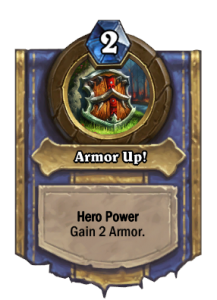 Warrior’s Hero Power is Armor Up. After being activated, it generates 2 points of Armor. It’s the most defensive Hero Power in the whole game. Even though the effect is similar to the Priest’s Lesser Heal, there are two main differences. On one hand, Priest’s one is better when it comes to the board control, because it can also be used on minions. On the other, Warrior’s Hero Power is superior when it comes to survivability because Armor has no upper cap while health is capped at 30. Defensive Warrior decks often end up with 50 or more points of effective health thanks to all the Armor they can stack.
Warrior’s Hero Power is Armor Up. After being activated, it generates 2 points of Armor. It’s the most defensive Hero Power in the whole game. Even though the effect is similar to the Priest’s Lesser Heal, there are two main differences. On one hand, Priest’s one is better when it comes to the board control, because it can also be used on minions. On the other, Warrior’s Hero Power is superior when it comes to survivability because Armor has no upper cap while health is capped at 30. Defensive Warrior decks often end up with 50 or more points of effective health thanks to all the Armor they can stack.
The Warrior’s main theme is playing around with damage. They run a lot of effects which deal small amounts of damage, either to single targets or as an AoE. This can be and often is used to damage your own minions. Doing this can activate many synergies and some unique removals. But it’s not only about the minions – Warriors also get stronger as they take more damage. When they fall below a certain amount of health, some spells have additional effects.
Starting with the damage effects – Warriors have multiple ways to deal 1 damage to things in order to activate either positive synergies on their own minions or removals against enemies. They can deal one damage to a single target with Inner Rage, Cruel Taskmaster and Blood To Ichor, or AoE damage with Whirlwind, Revenge, Ravaging Ghoul or Blood Razor. Damaging their own minions can be helpful if your deck is running Enrage minions (e.g. Bloodhoof Brave or Grommash Hellscream) or minions that have some kind of effect when damaged (e.g. Acolyte of Pain, Frothing Berserker or Grim Patron). Alternatively, damaging your own minions can be helpful if you run cards like Battle Rage, Rampage, Blood Warriors, Sudden Genesis or Crush. On the other hand, you want to damage opponent’s minions to activate some of the most powerful removals in the game – Execute, Sleep with the Fishes and King Mosh.
Learn more about Warrior in World of Warcraft via Wowhead’s class guides: Arms Warrior Guide, Fury Warrior Guide, or the Protection Warrior Guide!
Sometimes, the Warrior might also want to take damage itself. There are some card effects that synergize with a damaged Hero. Battle Rage draws an extra card if your Hero is damaged (even a single point of damage will do), while Revenge and Mortal Strike get more powerful when the Warrior is at or below 12 Health.
There are also some ongoing themes when it comes to the Warrior cards. When new cards are released, there is a significant chance that some of them will fall into one of those categories:
- Armor – Warrior is the main class when it comes to stacking Armor. The class can gain armor through a variety of ways besides the Hero Power – there are multiple spells (Iron Hide, Bring It On!, Shield Block, Bash, Ironforge Portal, Unidentified Shield) and minions (Armorsmith, Drywhisker Armorer, Alley Armorsmith, Shieldmaiden) that give extra points of Armor. There are also some cards that synergize with Armor (Shield Slam, Bladed Gauntlet, Reckless Flurry, Geosculptor Yip). We can expect more and more cards related to Armor in the Warrior class.
- Taunt – Up until Journey to Un’Goro, Warrior had a higher than average number of Taunts and Taunt-related cards. However, with no real incentive to use them, only a few of them even saw play. Everything has changed with the Un’Goro expansion with the release of Quests. Warriors got Fire Plume's Heart which gives the class a large incentive to play a Taunt themed deck. It would be too long to list every card, but some of the most popular Taunt cards in Warrior include: Fierce Monkey, Bloodhoof Brave, Alley Armorsmith, Direhorn Hatchling, Gemstudded Golem and Ornery Direhorn. When it comes to the Taunt synergies, there are some of them (e.g. Bolster, Stolen Goods), but they rarely see any play.
- Weapons – While Warrior is only one of the five weapon classes, it’s probably the most weapon-focused class of them all. Not only does the class have access to the highest range of weapons, but it also has a lot of minions which summon weapons and weapon-related effects. Some of the most popular Warrior weapons include Fiery War Axe, Death's Bite, Arcanite Reaper, Blood Razor and Gorehowl. The minions that summon weapons also have seen quite a decent amount of play (N'Zoth's First Mate, Arathi Weaponsmith, Malkorok). On top of that, Warriors have access to multiple effects that buff their weapons – Upgrade!, Bloodsail Cultist, Orgrimmar Aspirant,Grimestreet Pawnbroker and Hobart Grapplehammer.
Strengths and Weaknesses
Strengths: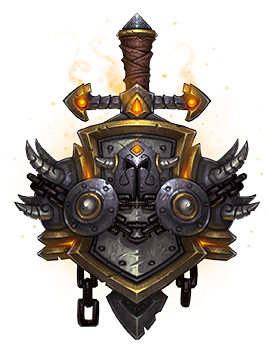
- Weapons – Weapons are the Warrior’s main strength and its primary advantage over the other classes. Aggressive Warrior decks can utilize weapons as reach. They’re often far superior to classic burn spells because they’re much more mana efficient and they can be buffed. For example – Arcanite Reaper is a five mana Pyroblast if you hit the opponent’s Hero twice. While it has some obvious disadvantages – it can get removed, Taunts can block it, only half of the damage is immediate – it also has some significant advantages – it’s five mana cheaper and a single Upgrade! effect increases the total damage from 10 to 18. In a slower Warrior deck, weapons are a very efficient way to deal with minions. Fiery War Axe used to be one of the best cards in the game just because of how much early game control it gave (after it got nerfed to 3 mana, it’s still a decent weapon, but it’s no longer such a staple). Some of the weapons, like Fool's Bane or Gorehowl can get even more value.
- Removals – Warriors are great at removing things. I’ve already partially covered it in the weapons section, which are the backbone of the Warrior’s removals, but there are multiple more ways to deal with stuff. Warriors have access to removals for pretty much every scenario – they can ping (Blood To Ichor, Cruel Taskmaster), deal small amounts of single target damage (Slam, Bash), destroy pretty much every single target under certain conditions (Execute, Shield Slam), deal small (Whirlwind effects) and moderate (Sleep with the Fishes) amounts of AoE damage or even potentially wipe the whole board (Brawl, Reckless Flurry). This huge range of different removals made Warriors one of the strongest Control classes for a long time. While Control Warrior isn’t very strong in the current meta, it will surely come back one day.
- Defensive Mechanics – Warriors are both masters of offense and defense. If you build a defensive Warrior, it can counter pretty much any Aggro deck. There are two main defense mechanics that Warrior has – Armor and Taunts. Armor is basically life gain, which is great against fast decks that want to rush you down. Your Hero Power “heals” your Hero for 2, while there are multiple cards that let you gain even more health to get out of the reach – e.g. Shield Block or Armorsmith. The Taunts are just as simple – if you put a Taunt between the Aggro deck and your Hero, he has to get through it first before he can attack you. A deck with multiple Taunts is a great counter to any aggressive strategy relying on the minions and/or weapons. It’s possible to build a very anti-Aggro Warrior deck that can thrive in an aggressive meta.
Weaknesses:
- Bad Hero Power – The Warrior’s Hero Power might be the worst one in the whole game. While yes, it’s great in some matchups (like versus some combo decks), most of the time you wish you’d have something else instead. If you’re playing an aggressive deck, gaining Armor is pretty much pointless. It sometimes comes handy in the Aggro mirrors, but you’d still rather have something else most of the time. And in slow matchups, stacking Armor up to 20 or 30 is cool, but you’d easily change that Hero Power for something that can effect the board or gain value. The only matchups where the Hero Power is really useful is when you’re playing the Control and the opponent is playing something aggressive, but then again, you’d still prefer the Priest’s one in that scenario.
- Conditional Cards – If everything lines up perfectly, Warrior decks are nearly unstoppable. But in reality, a lot of things can go wrong. The thing about Warrior cards is that they’re incredibly powerful when the conditions are met, and pretty weak or even useless if they aren’t. Let’s take some of the basic Warrior removals – Execute and Sleep with the Fishes. If you have no way to first damage the minion you want to Execute or whole opponent’s board, those cards are pretty useless. To be really effective, they first need to be combo’d with something (like Blood To Ichor in the case of Execute and Whirlwind in the case of Sleep with the Fishes). Not to mention that the Warrior AoE’s are mirrored, which makes them difficult to use when you have some board presence too – e.g. you sometimes have to sacrifice your own minions if you really need to Brawl, because your opponent has played something you can’t otherwise deal with. Also, the weapons and weapon buff effects – Upgrade! and Bloodsail Cultist are very strong, threating tons of extra damage. But then, they’re both very underpowered with no weapon equipped (or no Pirate on the board in case of Corsair). Upgrade does indeed create a new 1/3 weapon and Bloodsail Cultist is a 3/4 minion, but it’s not something you would put into your deck. There are much more small examples, like Battle Rage with no damaged targets, Revenge or Mortal Strike when your Hero is above 12 health or Grommash Hellscream with no way to Enrage him.
Meta Decks and Strategies
Here are the Warrior decks you can use on the ladder in the current meta. While not every deck listed here is high tier, they all should be viable options, especially to climb through the lower ranks.
Pirate Warrior was the most prominent Warrior strategy for the last few expansions, maybe even one of the most powerful decks in the history of Hearthstone. However, a seemingly small nerf during Knights of the Frozen Throne – changing the mana cost of Fiery War Axe from 2 to 3, made it significantly worse. The problem is that Warrior’s Turn 2 was already very weak – War Axe was usually the best play you could make, and having it on the curve often meant that you could follow-up with a powerful 3-drop while having the weapon for the board control. Right now you often need to choose between playing the weapon on Turn 3 (and getting the board control) and playing a minion (to be aggressive).
Pirate Warrior nearly disappeared from the meta after the nerf, but some people still play it. Prince Keleseth became a go-to card to run in the Pirate Warrior, because the only 2-drop Pirate Warrior really wanted to run was Bloodsail Raider.
However, Kobolds & Catacombs have introduced another twist to the deck. Most of the builds right now try to, let’s just say, cheese out a victory with a Spiteful Summoner high-roll. The deck has removed any cheap spells and runs only two copies of Lesser Mithril Spellstone. While the initial aggressive curve is much worse than it used to be, a Turn 6 4/4 (or 5/5 after Keleseth) + a random 7-drop is quite strong. If you follow it up with the actual Lesser Mithril Spellstone, which might even summon three 5/5’s, you can seal some games that way. However, the deck struggles against even more aggressive and/or high tempo decks, which are common in the current meta. So in the end, while it’s probably the best way to play Warrior right now, it’s not very impressive.
Control Warrior has a long history as one of the top decks in Hearthstone. Sometimes called Wallet Warrior, it started out in the early days of the game as a legendary-heavy deck that could take its opponents to the late-game and find its way to victory using its many big, and typically legendary, threats.
After The Grand Tournament, Justicar Trueheart became the defining card of the archetype. Control Warriors would spend turn after turn tanking up, reaching armor levels that could add up to an effective health pool of 100 or more in slow control mirrors. Warrior still had big threats in the deck, but it could more and more often win simply through fatigue, outlasting anything and everything the opponent could throw at it. Fatigue Warrior as its own archetype, solely focused on winning by running its opponent out of cards, was experimented with as well, but could not quite overcome the more traditional Control Warrior that was able to win through other means as well.
Whispers of the Old Gods brought new tools for slow decks in the form of the Old Gods, two of which found their way to slow Warrior decks. C’Thun Warrior became the prevalent type of Control Warrior, able to outlast opponents and finally finish the game with burst from C'Thun – or up to three C’Thuns, if it was successful in reshuffling new copies into the deck with Brann Bronzebeard and Doomcaller. N'Zoth, The Corruptor Control Warrior, on the other hand, could go for a strong swing turn with resummoned Deathrattle minions. Regular Control Warrior also lived on alongside these newcomers.
The long reign of Control Warrior came to an end with Mean Streets of Gadgetzan and its Jade Golems. Jade Druid’s immunity to fatigue and endless threats proved to be a devastating counter to Control Warrior, and while the archetype could still find occasional success, its popularity waned for the first time in the history of the game.
Journey to Un’Goro kind of brought Control Warrior back: Taunt Warrior, running the Warrior Quest Fire Plume's Heart, bore a level of resemblance to the Control Warrior of old. Yet, it was different in many ways: it lacked the armor gain and endurance of the old builds, and it had a brand new win condition with its Ragnaros Hero Power. With Jade Druid still running strong, more traditional Control Warrior remained occasionally played, but not a common sight. Having a hard time against the new Taunt Warrior did not help either.
Knights of the Frozen Throne is a set that promises to reverse the fortunes of Control Warrior. There is a new counter to Jade Druid in the set, as Skulking Geist can take out all Jade Idols from the player’s hand and deck, and there are new tools for delaying fatigue with Dead Man's Hand and new Deathrattle minions for N’Zoth to resummon, especially Mountainfire Armor and Bone Drake. Traditional Control Warrior, Fatigue Warrior, Giants Warrior, C’Thun Warrior, and N’Zoth Control Warrior all look like decks that can find at least some success in the new meta.
Alas, the fortunes of the archetype look somewhat worse in Kobolds and Catacombs. Decks are able to build strong boards time and again, and if you include enough removal in Control Warrior to beat that – there is enough available to remove everything a Big Priest can play even with two full Spellstones – you will lose in matchups that are not focused on the board as you have a ton of useless cards there. As a result, slow Warrior decks are among the worst-performing decks in the game at the moment. You can build them to beat any individual matchup – you just cannot take them all at once.
Control Warrior right now is difficult to recommend for climbing the ladder.
Budget and Basic Decks
If you’re a new player without a big collection, you might be looking for a way to play Warrior without spending a lot of your Dust on the Legendaries.
A Basic deck is a deck with only the starter cards. Every player can make it after unlocking the class and leveling it up to 10 (which unlocks every Basic card). It’s a best solution if you have just started playing the game – you can test each class without investing into it.
A Budget deck is a cheap deck with no Epics, Legendaries or Adventure cards. Budget decks only run the basic cards + Commons and Rares, which makes them relatively cheap and accessible even for players who have recently started. Average budget deck will cost up to 2,000 Dust to craft, but the number goes down heavily when you own some of the cards already. Even with a relatively small collection, you should be able to build one with just a few hundreds of Dust.
Basic decks are mostly meant for the Casual mode and up to Rank 20 in Ranked. Budget decks can easily be played up to Rank 10 in Ranked, while some of the better ones can even get you up to Rank 5.
This deck is a Basic Aggro Warrior. Alongside the Hunter deck, it’s the most aggressive Basic deck available. Weapons are the Warrior’s characteristic feature, and they excel at two things – controlling the board or dealing a lot of damage to the opponent. For example, Fiery War Axe, even though it was nerfed, is still a great Basic card. Most of the other early game removals let you deal with only a single small minion – weapons like War Axe allow you to clear two of them. Or deal six damage to the opponent. Weapons, especially Warrior weapons, are one of the most efficient burn tools in the game. The downside is that the burn is spread over more than a single turn and it can be blocked by Taunts and Freeze effects, but it’s still really worth it. Arcanite Reaper alone can take down a third of the opponent’s starting health. Basic decks rarely run a lot of the efficient defensive tools, meaning that the aggressive strategy might work very well.
Basic Warrior deck is very all-in. You need to take a lot of risks when playing it. All game long you have to play for the tempo, you won’t really outvalue most of the opponents. You’ll often take opponent down to low health and the games will be decided by whether he has some sort of Taunt minion or heal. On the other hand, if you get a quick enough start, you’ll sometimes finish the game as soon as Turn 6-7 by being really aggressive.
Basic Warrior is not the strongest deck around, especially because of the Hero Power. It’s probably the worst Hero Power for a Basic deck, since it doesn’t affect the board in any way, can’t damage the opponent and has no synergizes with the deck. At the same time, Basic Aggro Warrior might be a good choice, because it’s very easy to upgrade it and after a few investments you can turn it into a budget Pirate Warrior, which is a solid meta deck and can get you really far.
As an archetype, Pirate Warrior exists for a really long time. People have experimented with Pirates and weapons for a really long time. But the true reign of Pirate Warrior has started back in Mean Streets of Gadgetzan, mainly thanks to the Patches the Pirate, which added a lot of the early game tempo to the deck (and well, Small-Time Buccaneer, but it was nerfed later). The deck was more or less dominating the meta (being a Tier 1 deck nearly all the time) for over 9 months, but then the nerf recent nerf patch hit it hard.
With only a single change – increasing the mana cost of Fiery War Axe from 2 to 3 – the deck went from dominating to mediocre. It’s still viable, but a very weak Turn 2 has lead a lot of the players to simply using a Prince Keleseth strategy, which means dropping any 2 mana card.
That nerf was also a huge hit to the budget Warrior players. Pirate Warrior is really the only viable budget deck for Warrior, and the Fiery War Axe nerf hit the non-meta build even more than the actual one (because budget players can’t afford to just slam Prince Keleseth in). Before, Pirate Warrior was probably the best budget option out there. Right now, it’s still better than some of the other budget decks, but it’s below average. Especially since the meta is full of Golakka Crawler techs right now.
As for the Kobolds & Catacombs, Pirate Warrior has got exactly… zero budget cards this expansion. Or, let me rephrase it, Pirate Warrior has got zero really good cards this expansion, let alone cards that budget deck can play. Which means that, sadly, the list won’t change in the slightest.
Most of the Constructed Pirate Warrior lists (which are still pretty rare) run an interesting combo – Spiteful Summoner + Lesser Mithril Spellstone and no other spells at all. Which means that playing Summoner on Turn 6 results in a 4/4 + a random 7-drop, which is a huge tempo play. After the initial aggression, it’s very likely that your opponent is nearly out of removals already, which might make it hard to remove. Mithril Spellstone also isn’t that bad in a deck like that, given that you equip a lot of weapons (minions that give you a weapon, like N'Zoth's First Mate do count) and having 3x 5/5 as a finisher can also win you the game.
However, even though Spellstone is Rare, Spiteful Summoner is Epic, so it doesn’t quality for our budget deck. Which, in the end, means that the budget deck didn’t change at all.
Level-up Rewards
Every 2 levels, up to level 10, you will get two copies of a Basic class card. A lot of those cards are staples, so it’s heavily advised to highly prioritize getting every class to level 10.
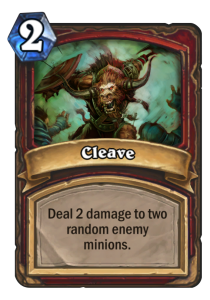 |
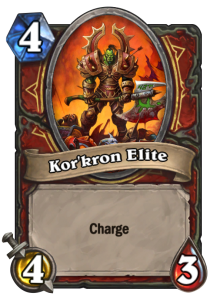 |
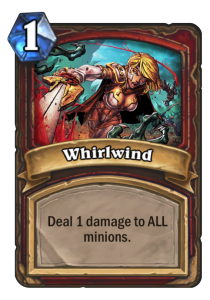 |
| Level 2 | Level 4 | Level 6 |
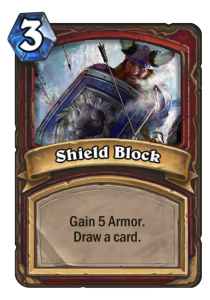 |
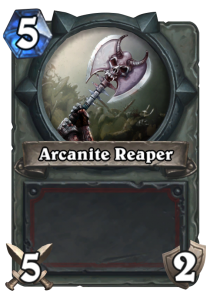 |
| Level 8 | Level 10 |
Every few levels past level 10, you will be rewarded with a Golden version of one of the Basic cards. Leveling up past 10 doesn’t give you any competitive edge – all the rewards are cosmetic.




















































